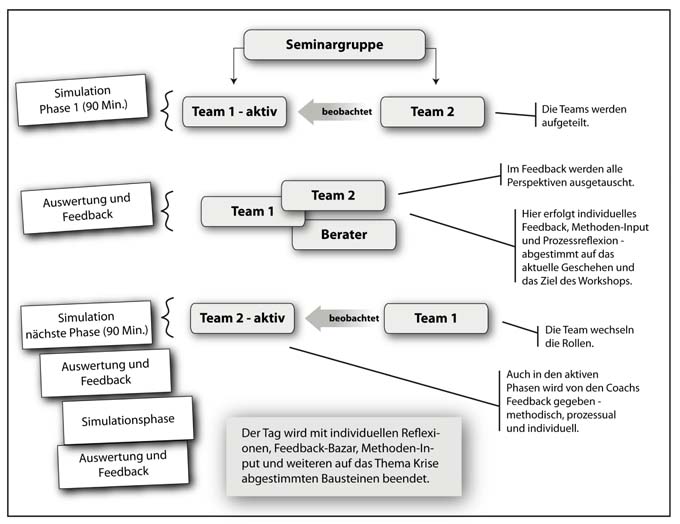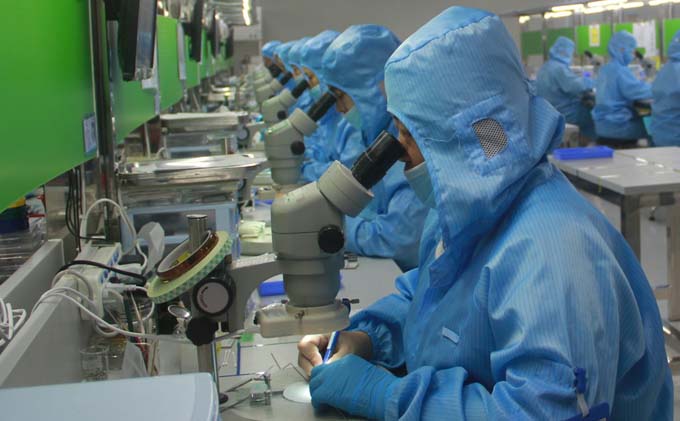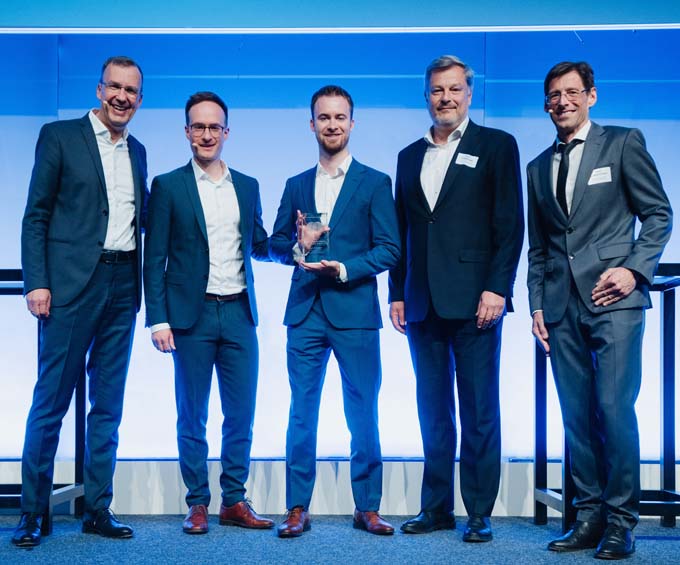Managing the complexity of situations: training with simulations
In a VUKA world characterized by rapid change and decreasing predictability, managers are increasingly faced with the challenge of mastering complex situations. This competence can be taught to junior executives with business simulations. This project report shows that.

Companies must provide their junior managers with the skills to recognize changes in the company and its environment from which new challenges could arise at an early stage, as well as to tackle new challenges courageously. And finally, it must be a matter of successfully managing the areas entrusted to them in a changing environment. In doing so, companies often struggle with the problem that although they can sensitize their junior managers to the complexity of the environment in which they operate and the multi-layered nature of their management tasks in seminars, this complexity and multi-layered nature cannot be experienced in classic seminars. This is why the young executives do not develop the behavioral confidence they need for their (future) leadership work.
Making complexity tangible
That's why, in the fall of 2021, a global technology company that supports Machwürth Team International (MTI) in human resources development decided to conduct a business simulation as part of its leadership development program, in which participants would
- experience the complexity of the environment in which leadership takes place "live", so to speak,
- Try out different problem-solving and management strategies,
- reflect on their actions together and
- identify and try out alternative approaches so that they ultimately have a larger repertoire of actions and their behavioral confidence increases.
In addition, through their trial actions in the business simulation, the junior executives should develop a sense of where there is still a need for development in themselves and in the team if they want to have the desired effect as a leader.
Acting unerringly in a changing environment
First, the human resources developers at the company worked with the project managers at MTI to modify an existing business simulation program so that it reflected the challenges facing the company. The program was adapted to the specifics of the company and its market, from sales developments, production and personnel data to so-called "black swans" - unexpected events such as the Corona pandemic and its economic consequences - so that the simulation could work with real data and reflect several economic periods.
The central challenge was defined as: The company is under high pressure to innovate because its market is changing rapidly and technical progress is constantly enabling new solutions to problems. As a result, the company's strategies and business plans have an ever shorter shelf life. So the divisions also have to regularly rethink and readjust their strategies as well as their processes. This gives rise to the following challenges for managers, among others:
- You need to recognize the need for change early on.
- In addition to their employees, they often have to win over the areas with which they cooperate and their superiors as fellow campaigners to set a new course. And:
- Managers must coordinate their actions and act purposefully as a team.
Learning to manage complexity
Once the preparatory work was completed, a three-day workshop was held in December 2021 with twelve young managers from the company. It started on a Tuesday afternoon. The participants first reflected together:
- What is the function of leadership?
- What are the prerequisites for achieving top performance as an organization over the long term in an era characterized by change? And:
- What demands does this place on leadership?
In two teams of 6, the participants each created a collage that illustrated these connections. These were presented and debated in the plenary session. Afterwards, the two Machwürth consultants who led the workshop introduced the simulation program to the participants. They also explained the content setting to them. Afterwards, the participants received their role descriptions in the business simulation so that they could already think about it in the evening:
- How do I adequately perform this role and
- what behavior should I show as a leader?
When assigning roles, care was taken to ensure that the young executives were deployed in areas alien to their specialist discipline. For example, production managers became purchasing managers and HR specialists became finance managers. This was to prevent the participants from relying primarily on their specialist knowledge when tackling the challenges in the business simulation. After all, this was not intended to deepen their technical expertise; rather, they were to learn how to remain capable of acting as managers and teams in a complex environment characterized by numerous interdependencies and changes.
The actual business simulation began on Wednesday morning. It consisted of five 90-minute simulation phases, each of which was followed by modules in which the participants reflected on their approach and behavior in the simulation under guidance or dealt with a topic relevant to managing departments. During the business simulation phases, one of the two groups of participants always acted as the management team, while the second group observed them and then gave them feedback. In the next phase, the roles were reversed: the second group continued the simulation while the first group observed it.
The participants are sometimes actors, sometimes observers
In the first phase of the simulation, the content setting was: The company is running smoothly and its business is stable. However, the first weak signs indicate that the general conditions will change in the foreseeable future. Central questions to which the executives were to find an answer in this phase were:
- How do I behave as a manager (or management team) in such a situation? And:
- How do I recognize changes early on that could result in new opportunities or risks?
The members of the second group observed the members of the first during the simulation. Afterwards, their actions were reflected on in plenary before finally the Machwürth consultants gave an impulse lecture on the topic of "Recognizing changes early on", in which they once again clarified it for the participants:
- What tools/methods are available to identify change?
- At what levels can they occur?
- How to evaluate the registered changes in terms of their relevance for the company? And:
- What responses to potentially relevant changes are possible/appropriate?

The second simulation round followed in the afternoon. Now the second group of participants was active and the first was observing them. The setting was now: The company's business continues to be stable, but the signals that the environment in which it operates is changing are intensifying. In the business simulation, the executives were now faced with the challenge of deriving concrete information from the environmental signals as to whether certain courses might need to be set anew in their own area or in the organization; in addition, to seek discussion with other executives as to whether they were registering similar signals in their area, in order to subsequently start a dialog in the management team as to what measures might need to be taken. This simulation phase was followed by another round of reflection in the plenary session, in which the participants also reflected on their cooperation and interaction. This was followed by further input from the Machwürth consultants - this time on the topic of how information about impending changes can be collected, sorted, structured and evaluated in order to identify the need for change.
The pressure to make decisions and take action increase
The two simulation phases on the next day also followed this pattern. In the process, the need for and pressure to make decisions and take action became greater and greater - for example, because important key figures such as sales and orders on hand suddenly showed negative signs or competitors launched new, strong competitive products on the market - so that finally, in the fourth phase of the simulation, it was obvious to (almost) all members of the fictitious organization:
- "If we had not committed to a changed approach and taken initial precautionary measures in Phase 3, we would have slid into a crisis." and
- "If we don't reset the course now, we won't achieve our medium- and long-term goals as an organization."
When dealing with the associated challenges in the business simulation, the managers were able to pull out a "consulting card" if necessary and contact a Machwürth consultant. However, the consultant only gave them the specific information they were looking for and pointed out possible alternative interventions. Afterwards, the executives had to decide for themselves whether these were goal-oriented. In addition, the consultants sometimes stopped the simulation at significant events, whether at the process level or at the level of cooperation and interaction, by means of a "time-out" in order to reflect with the participants on what had just happened and to safeguard the learning processes.
Safeguarding and expanding what has been achieved
In the fifth and final simulation phase on Friday morning, the aim was to check whether the change measures taken were having the desired effect; and, if so, to ensure their sustainability and that the newly designed processes, procedures and structures had the necessary stability. This was again followed by a joint reflection on the simulation in the plenary session, before the Machwürth consultants again gave input on how change processes can be managed - at the personal and organizational levels. In doing so, they regularly referred to what the participants had experienced in the simulation - also in order to create the memory anchors that are important for transfer. In a detailed final round, the participants then summarized once again what they had learned most during the last few days and what they would like to transfer from what they had learned to their everyday work. The workshop was then concluded.
Through the practical business simulation, the company succeeded in increasing the sensitivity of its young managers to the complexity of their management tasks and the numerous interdependencies that have to be taken into account in this context. In addition, the targeted testing of various management, behavioral and cooperation strategies increased their ability to act in an environment characterized by change. The technology company benefited directly from this when, following the outbreak of the Ukraine war in February 2022, not only did procurement problems intensify. That's why it decided: Business simulation should henceforth be a fixed component of our management development - worldwide.
Author:
Hans-Peter Machwürth is Managing Director of the internationally operating training and consulting company Machwürth Team International (MTI Consultancy), Visselhövede (www.mticonsultancy.com).









